#director Kitano Takeshi
Explore tagged Tumblr posts
Photo

Takeshi Kitano
74 notes
·
View notes
Photo




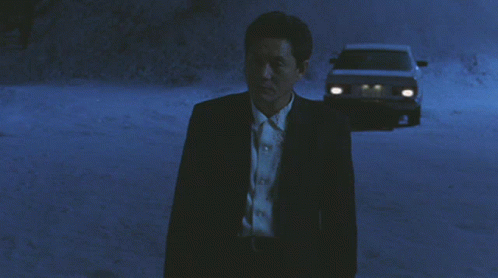

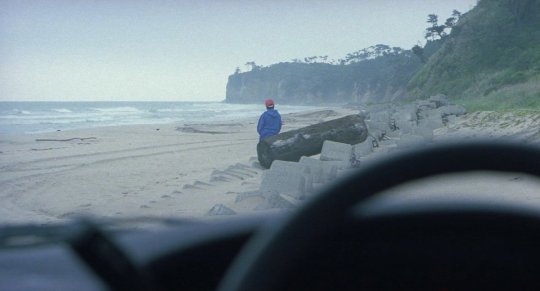


SUBLIME CINEMA #653 - HANA-BI
Humanist take on a gangster picture that nabbed Beat Takeshi a Golden Lion in Venice and finally garnered him respect as an artist behind the camera as well as in front of it.
#cinema#film#movie#movies#filmmaking#Japan#films of Japan#Japanese director#Japanese cinema#cinema of japan#beat takeshi#takeshi kitano#ren osugi#Susumu Terajima#Kayoko Kishimoto#Hakuryû#filmmaker#great film#hana-bi#hana bi#fireworks#films#director#cinephile#entertainment#gangster#yakuza
114 notes
·
View notes
Text

Beat Takeshi
#takeshi kitano#beat takeshi#art#illustration#drawing#dessin#doodle#character#sketch#blackandwhite#digital#red#portrait#redraw#director#japan
3 notes
·
View notes
Text

Shoot out from Sonatine - Takeshi Kitano 1993.
#japanese film#yakuza#sonatine#takeshi kitano#actor director#shoot out#cult film#gifrun#my gifs#youtube#bfi#james riddlington steinway
0 notes
Text

I created a parody of director Takeshi Kitano's 'Outrage' poster using Monster.
And here's the original poster.

98 notes
·
View notes
Text
that game makes me want to talk about kubi (2023) by director takeshi kitano so bad, if you're interested in horny toxic yaoi gay samurai pls watch it, spoiler it's gay as hell
#actual spoiler>#was very happy to see yasuke in this#also very happy about how silly and gay this film is( yes i think it's a comedy#kubi 2023#queer palm nominated if i remember right#also I think maybe this is like probably i don't know the closest we can get seeing yasuke and nobunaga (almost) fucking on big screen
2 notes
·
View notes
Text





On January 18, 1947, Japanese film director and actor, comedian, screenwriter, writer, poet and artist Takeshi Kitano was born. In all his works, except for directing, he uses the pseudonym Beat Takeshi.
3 notes
·
View notes
Text



One fire day
[in Chacun son cinéma]
Director: Takeshi Kitano
2007
7 notes
·
View notes
Text
Pink Couldy Sky, Chapter 07 – Letter (Summarized) - Part 1
Note 1: Once again, the chapter is split into two parts. This first parts has the majority of it, but the secong part contains a long section that is actually, directly translated, and I will need more time to edit it properly. I hope to have it up before the year is over, but I can make no promises.
Note 2: This post contains pictures. I am not happy with how tumblr is sizing/cropping them on my screen. Click on them if they are not shown in full.
Chapter 00 - 01 Chapter 02 Chapter 03 Chapter 04 Part 1, Part 2 Chapter 05 Chapter 06 Part 1, Part 2
Under Professor Arakawa, REM’s days of acquiring knowledge as a dentist continued after graduation. He joined Arakawa’s study group where he gained practical experience on various cases and worked very hard on becoming an actual dentist. Otherwise, he wouldn’t have been able to justify himself to his late mother, nor to hide and the other members of SAVER TIGER. Those feelings were his main driving force. The other members of his dentist-band AMIT also joined Arakawa’s study group and they pushed each other forward.
To REM, who was practical by nature, this study circle was very helpful. He learned about the technical aspects from a medical point of view, and also about mental self-discipline.
In this time, again thanks to Professor Arakawa, REM also met Beat Takeshi, aka Takeshi Kitano [born 1947, actor, director, comedian etc.].
He vividly remembers the first time they went drinking together. They met at Takeshi’s place and he took REM to a snack bar in Roppongi’s underground. Takeshi was in a good mood and sang a lot at karaoke. His way of singing was exactly as REM had imagined it would be. Song after song he got on the floor and fired off jokes in rapid succession.
Takeshi seems blunt, but REM thinks he actually has a direct and kind personality and is very aware of his surroundings. When REM showed him a photo from is SAVER TIGER days, Takeshi laughed and said, “You really were a dentist already. Time didn’t change you.” Then he got serious and said, “But it’s interesting. Do your best.” The timing and the delivery were exquisite. [Note: I’m guessing that there was a joke in there that I fail to make sense of.]
When they talked about hide and discussed music, Takeshi pulled out one creative idea after another.
“When Doctor REM does a live, I’ll secretly enter the stage with no announcement, sing one song, and leave again without saying anything.”
It was a very fun night of drinking. They separated with REM excitedly promising to make that song for him.
Come to think of it, this was just one week before that unfortunate accident befell Takeshi. [Note: This is likely referring to a near-fatal motor scooter accident on 2. August 1994, which may or may not have been a suicide attempt.]
After this, they met several more times, with Takeshi also coming to Yokosuka for drinks, and continued their exchange. Takeshi would probably scold REM for embarrassing him if he read this, but he truly is a generous and warm person.
-
Hide continued to call REM about once a month. When he called from overseas, REM had the habit of taking notes on his calls in his diary-substitute-notebook.
For example: “31. August. Call from hide in L.A. at 6:30 AM. Today, it seems Megadeath came to the studio and he listened to their rehearsal.
He chatted about various things with the former guitarist of Cacophony, who apparently speaks Japanese.
When they went to a Japanese-style iszakaya afterwards, Ron Wood was drinking there…”
Beyond that, he would always contact REM when he returned to Japan, come directly to his apartment from Narita airport, and drink until morning to combat jet lag.
In the first half of the nineties, “X” turned into “X JAPAN”. In this time, hide rapidly grew not only as a guitarist but as an artist in general.
In 1992, he showed his talent as a visualist with the publication of his solo-photobook “Mugongeki”. His stage turned from Budokan to the Tokyo Dome to the world. REM, on the other hand, having given up music, turned into a normal dentist.
However, whenever hide returned to Yokosuka, they would go drinking at Dobuita together – as drinking buddies, as best friends, as music companions who would forgive each other for every stupid thing said.
In a sense, it was a pretty strange connection.
Now, REM wonders if it wasn’t obvious that he was holding back around hide for fear of bothering him. To say nothing of the fact that the bitter feeling of not having been there for hide when he needed him most would not leave him alone.
But – and he thinks it may sound pretentious to put it like this – REM wonders if in this town of Yokosuka, where hide had been born and raised, all the cloudy hesitation and misunderstandings and strange fears weren’t blown away by the constant salty breeze from the sea.
REM couldn’t help but think that way.
When they drank at Dobuita until morning, there were no obstacles between them.
Hide always listened intently to REM’s silly music stories. Is that artist good or not, which CDs are cool – he always had an earnest discussion with REM about these things.
Looking at hide’s carefree smile, REM always heard a voice deep in his heart, saying, “Now I owe him again…”
Without his noticing, that murmur changed to, “No matter how, I want to pay him back. No matter how many years it takes, one day I will…”
One day when hide was in Yokosuka, REM went to “Parkside X” together with Professor Arakawa. He’d been thinking that he should introduce hide to Arakawa, so when they happened upon him, REM introduced him with the words, “Arakawa-sensei, this is hide.”
And Arakawa smiled and stood with, “My pleasure, I’m Arakawa.”
Hide, also standing, looked a little nervous, and said, “Likewise. Thank you for always taking care of REM. I’m hide.” He removed his trademark hat and sunglasses and gave a quick bow.
Then, he slowly put them back on and apologized for being impolite by wearing those things while drinking, and sat back down.
REM was astonished that he had taken them off at all, because at that time, he never did that in public. It seemed that hide was particularly respectful towards Arakawa because of the relationship he had to REM, and REM’s surprise soon turned into deeply moved gratitude.
After a night of drinking together and talking about all sorts of things, Arakawa also praised hide as a young man who, striking appearance aside, had firm opinions and was very polite. The way in which hide expressed his friendship that night had been typical for him.
-
In December 1995, REM announced that the was leaving his bachelor life behind and got married to a woman named Miwa. [Note: At least, that’s what I think her name is. REM gives the kanji for her name, but not the reading, which might differ drastically from the common (or even any sensible) reading of the characters.]
For the wedding reception, they reserved a cozy restaurant for their few dozen guests, which included family and only their closest of friends. One invitation was handed to hide, who was happy as if it were his own wedding and confirmed that he was definitely going to attend.
On the day of the wedding, REM was nervous and embarrassed like never before in his life. This was no fault of his bride’s, he simply had a raging case of wedding nerves, and it defeated him. As soon as the nerves hit him, he would drink any alcoholic beverage he could get his hands on. He honestly thought that since it worked on stage, it would work for getting married.
Hide had sent them a large bouquet of flowers in the name of “X Japan hide” but was nowhere to be seen in person.
In fact, it seemed that hide had chosen his timing well, considering the commotion that might have happened at the gathering place if word had gotten around that a member of X Japan was present.
An hour into the event, hide was there, just sitting casually in the front row in his hat and sunglasses. He grinned when he handed more alcohol to REM. At this point, REM was already blazingly drunk.
Hide for his part was fidgety and restless, talking to Jimmy and pointing out that it was time for the afterparty.
Then, during the preparations for said party, those two kept whispering to each other about something.
The wedding reception was not unlike a live show, with plenty of music buddies present. There were former members of SAVER TIGER, Hikaru, who used to be the bassist of X for a while during their indies days, and the current, much more famous X Japan-bassist heath.
SAVER TIGER served as the lead act. With hide jumping in, it was like the illusion of a SAVER TIGER revival session. The song they played was “Double Cross”.
The title of the song seemed a bit too fitting for the situation, but they chose it because it was representative of SAVER TIGER.
So REM, unsteady and hugging his guitar, started to play (“Ei!”) with the timing he was used to, only to be met with perfect silence from everyone else involved.
Thus, he declared, “It can’t be helped, you’re all doing it wrong,” regained his composure and started playing the phrase again.
Once again, hide and the others met him with grinning silence.
And REM thought, “I’m being deceived!”, finally realizing that he was falling victim to a prank, and that the prank smelled strongly of hide. Surely, hide and Jimmy had set this up when they were whispering to each other before.
In that moment, the room erupted into laughter and hide smiled earnestly at REM while looking very satisfied.
REM’s memory of the events after this point are essentially nonexistent.
Among the things that he vaguely remembers are heath getting up on stage and accepting a trophy he had won at their bingo tournament with a smile, and hide’s younger brother Hiroshi being delighted about having won a guitar.
From what REM could put together from the stories of his wife and the others, hide gave a musical performance that day, looking truly happy. This was not X Japan’s hide, this was an amateur at a free-for-all, lost in the spur of the moment, strumming his guitar with a relaxed smile on his face.
“At least, he was grinning as he played and looked like he was truly having fun.” That’s what Jimmy always murmurs when remembering that wedding reception.
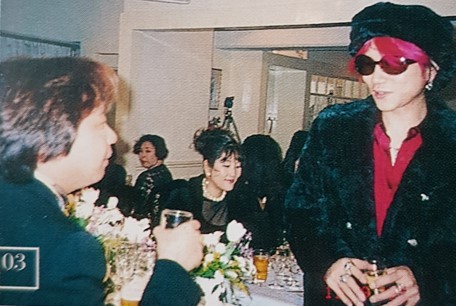


[December 1995: REM's wedding reception. Photos exist for when your memory doesn't. (Click on the image for full view if tumblr cut it weirdly.)]
Due to REM’s work, the newlyweds couldn’t go on honeymoon right away. Only in the following year, in spring 1996, was he able to take the time off for it.
REM and his wife immediately agreed on the destination they wanted to visit. They both recalled at once how hide had told them to come to L.A. at least once, so that was where they wanted to go for the occasion of their once-in-a-lifetime, somewhat late honeymoon: The L.A. where hide was.
REM called hide over there at once. When he told him, “We’re thinking of travelling to L.A.,”, hide said, “Wait a second, I’ll call you back,” and hung up.
He had probably gotten a call for work, was certainly busy right now… REM and his wife speculated such while they waited, but when hide called them back after only a sort time, he gave them a list of the major hotels in Los Angeles, with information on their rating, how far they were from the airport, the price, if it was okay to smoke in there, what attractions were nearby…
After hanging up on them, hide had researched all that at the speed of light. REM and his wife were nothing but grateful. Hide, for this part, was very enthusiastic about their upcoming visit.
“What do you want to do when you’re here?”
The two of them told him they wanted to watch a Nomo Game [Note: Probably referring to Japanese baseball pitcher Hideo Nomo, who was playing for the Los Angeles Dodgers at the time.], visit the Universal Studios, and other things. And hide said brightly, “I got it! You don’t need to take care of anything, just make the reservations for the flights and the hotel…”, and then quickly hung up the phone.
The weather in L.A. was clear.
They arrived at the hotel they had picked from hide’s list, checked in, and rested in their room for about an hour before hide arrived, going “Yaa, yaa, yaa!”
Hide was in the middle of recording his solo single “Misery” at the time and hadn’t slept in three days, but you wouldn’t know it from the way he acted. He was wearing his usual hat and sunglasses, and his usual smile that lit up his whole face when he said, “So, what’s the plan?” He pulled out pen and paper and wrote down the schedule for their stay in the city, while asking REM and his wife for their wishes. Then, he asked, “How do you feel about Las Vegas?” and added his own recommendations, arranging everything from flights to hotel reservations.
He also insisted that REM’s wife, pregnant at the time, had to eat! And handed over a bundle of ten onigiri that he had brought for her.
Her due day happened to coincide with hide’s thirty-second birthday. Whenever he stroked the bulging stomach of REM’s wife, he would tell the unknown baby to better get born on schedule, so they could share their birthday.
In any case, to REM and his wife, hide was the world’s best tour conductor, taking care of every aspect of their journey. His thoughtfulness, attentiveness, kindness and warmth were extraordinary and he made sure that they got whatever they wanted. REM and his wife could only be grateful and impressed by his warmth that asked for nothing in return.
It was thanks to him that this trip became one of the best memories of the couple.
One day, after hide had left for recording, his manager at the time, Kudo-chan, took them downtown for dinner. After parking the car, they waited at a traffic light, discussing where they wanted to eat.
As they waited, REM spotted a man waiting at the opposite side of the road who looked like a musician to him, from the way he dressed to the way he wore his long, lustrous hair. Then, the signal turned to “WALK”, they did just that, and as the guy came closer, REM thought that his face looked like he had seen it somewhere before…
It couldn’t be. Here, on this giant continent of America, in the middle of this giant city of Los Angeles…But damn, if that guy did not look exactly like…
And so it came that REM and heath embraced right there in the middle of that pedestrian crossing in L.A., celebrating their unexpected reunion. Babbling along the lines of:
-“Hey, what are you doing here? No, this is where I… Where are we, anyway…”
-“N- no, I heard from hide-chan that you were in L.A., REM, but that I would meet you here…”
Since the time heath came from Osaka to Tokyo, REM had often gone drinking with him. Their meeting here was as much of a surprise as when hide had told REM that heath had joined X.
Thanks to this prank of the gods, they all went to a Japanese restaurant together, chatting happily. It was a day full of surprises and deep emotions.
Just two or three days before REM and his wife were to return home, hide invited REM to the studio and asked him to play the guitar solo of “Misery”. So REM borrowed hide’s guitar and contemplated the song’s guitar phrase there in that place.
And after he played it, hide said, “Well, REM-chan, let’s have you record it before you go home!”
Somewhat incredulously, REM agreed.
However, the next day, something urgent came up with X Japan and the recording of “Misery” had to be interrupted.
Looking regretful, hide told REM over and over that it would resume the next week. But REM’s work did not allow for the delay. And so, with painful reluctance, REM and his wife boarded the plane home.
The day before their return, hide somehow managed to take them out for dinner despite his busy schedule. Since REM’s pregnant wife couldn’t drink, REM and hide drank beer and wine for three. Afterwards, they returned to hide’s apartment building, hung out on the roof at the pool, and continued to chat while looking at the giant, illuminated HOLLYWOOD-sign.
At some point, without anyone noticing, hide had taken off his sunglasses. Hide, who had returned to bare-faced Matsumoto Hideto, and REM, who had returned to bare-faced Araki Masahiko, continued talking with a beer in hand for a long time.
It had been more than ten years since REM had first come to this city as a middle school student. Now, the L.A. night breeze was as fresh as it had been back then, and so dry they could basically hear it.

[2 May 1996: Last night in L.A.]
The next day, hide was driving the car himself when he picked up REM and his wife who were puking all over due to hangover and morning sickness respectively and took them to the airport.
Hide seemed to enjoy himself when he looked over his shoulder at their pale faces in the backseat and asked with a smile, “Honored passengers, how did you enjoy your trip?”
That kind smile of hide, that rare entertainer, was swaying before their eyes.
Hide had been serious about what he had said at the studio in L.A., as REM came to understand that the afterparty of the secret live hide and his band gave at the Yokosuka Art Theater that autumn. He had really meant for REM to play the guitar for “Misery”. REM had been baffled, and felt that now there was another major depth he was owing hide.
He murmured those words as he watched hide’s cheerful form fussing around. His wife, who had heard him, nodded in agreement. She was approaching her due date.
“He’s really supported us at every important point, hasn’t he?”
And so he had. When REM and his now-wife had been dating, it was hide who had looked at them and declared that they absolutely had to get married. He kept saying it. He even said it on New Year’s Day of the year they did get married, just like hide had predicted.
In that moment, REM and his wife likely had the same mental image: Of hide, cheerfully playing guitar at their wedding reception with a mischievous smile on his face, or his kind hospitality in L.A., happily going along with everything they wanted. REM’s thought of, “I want to repay hide for all he’s done” turned to “I must repay hide” turned to “No matter how many years it takes, one day for certain,” and finally arrived at “I must start at once.”
On the sixth of December, 1996, about one week before hide’s birthday, REM’s wife gave birth to their first child without problems. It was a boy, and they called him 柊衣. [Note: The Japanese names strike again. This is probably read either “Hii”, “Toui”, or “Hiragi”.]
Hide came to meet their beloved son the following year, in February 1997.
Hide loved children. Even now, REM remembers how hide played with their son tirelessly all day. He passionately gave this baby, only two months old, rhythm training and taught him how to hold a guitar pick.
This was another day when hide took off his sunglasses. It is their absence that REM blames for the fact that hide, holding the baby in his arms, looked so innocent and vulnerable it hurt.
Continued in part 2
#hide#pink couldy sky#REM#summary#saver tiger#takeshi kitano#might as well tag him#japanese names are a thing and they haunt me#this is the happy part of the chapter#have some photographs of happy people
7 notes
·
View notes
Text
November 18, 2023
TOKYO (AP) — Japanese actor-director Takeshi Kitano says he wanted his new film “Kubi” to show the world of samurai in ways that mainstream movies have rarely done before, by portraying the homosexual, love-hate relationship of warlords in one of Japan’s best known historical episodes.
“What is never shown is relationships between men at that time, including their homosexual relationships,” Kitano told a news conference at the Foreign Correspondents’ Club of Japan on Wednesday ahead of the Nov. 23 opening of his film in Japan.
The story of “Kubi,” or “neck,” shows the 1582 ambush of Oda Nobunaga, one of Japan’s best-known warlords, at the Honnoji temple in Kyoto by an aide, Akechi Mitsuhide.
Past dramas from that period have only shown “very cool actors and pretty aspects,” Kitano said.
“This is a period when especially men were keeping up with their lives for other men within these relationships, including sexual relationships,” he said. ”So I wanted to delve into showing these more murky relationships.”
He wrote a script for the idea 30 years ago, then released the novel “Kubi” in 2019, leading to his production of the film. He also plays Toyotomi Hideyoshi, who takes over after Nobunaga, in the film.
Kitano, 76, began his career as stand-up comedian Beat Takeshi before becoming a TV star.
Kitano said he has seen the dark side of the Japanese entertainment industry, which recently has been shaken by a scandal involving the decades-long sexual abuse of hundreds of boys by the late founder of a powerful talent agency. Recently, the suicide of a member of a hugely popular female-only theater company Takarazuka prompted criticism over its alleged overwork and widespread bullying.
“In old days, in the Japanese entertainment industry, I wouldn’t go as far as calling it slavery, but people used to be treated a commodities, from which money is made while showing them off. This is something that’s still left in the culture of Japanese entertainment,” Kitano said.
In his early days as a comedian, there were times when he was paid not even one-tenth of the worth of his work, he said. “There have been improvements in recent years, but I’ve always thought severe circumstances have existed.”
Kitano, who debuted as a film director in 1989 with “Violent Cop” and won the Golden Lion at the Venice Film Festival for “Hana-bi” in 1997, is known for violent depictions in his gangster movies like “Outrage.”
“Kubi,” which refers to traditional beheadings, has ample violence. Violence and comedy are an inseparable part of daily lives, he said.
“Laughter is a devil,” he said. “When people are very serious, such as at weddings or funerals, we always have a comedy or a devil coming in and making people laugh.”
Same for violent films, he said. “Even when we are filming very serious scenes, there are comedic elements that come in on the set, as the devil comes in and makes people laugh,” though those scenes are not in the final version of films.
“Actually, my next film is about comedy within violent films,” Kitano said. It will be a two-part film, with his own violent story followed by its parody version. “I think I can make it work somehow.”
9 notes
·
View notes
Text
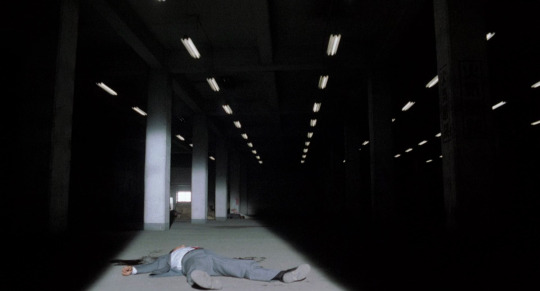
"Everyone's gone crazy."
Violent Cop (1989)
Director: Takeshi Kitano
Cinematography: Yasushi Sasakibara
11 notes
·
View notes
Photo

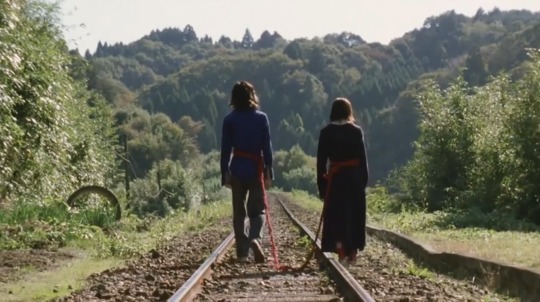

Dolls (2002)
Director: Takeshi Kitano
Cinematographer: Katsumi Yanagijima
11 notes
·
View notes
Text

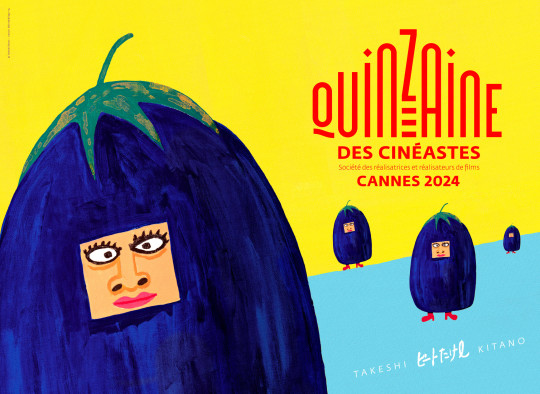
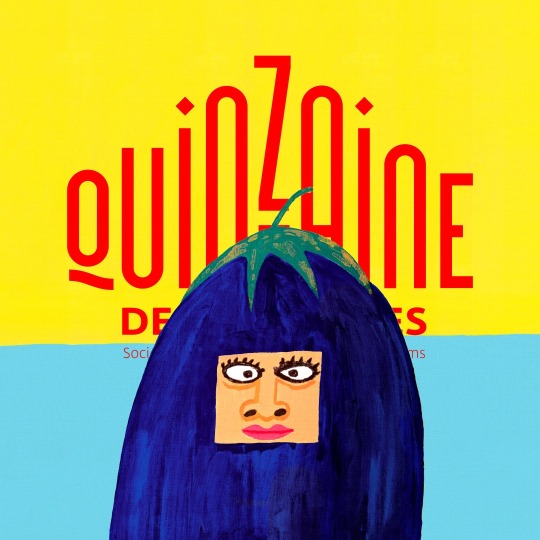

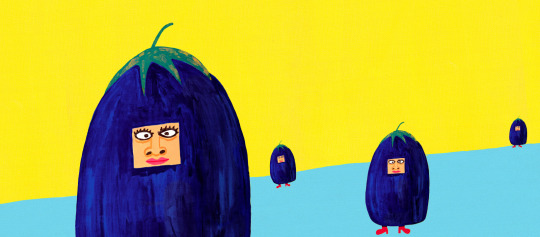
The 56th Directors' Fortnight poster is adorned with the schoolboy imagination of Takeshi Kitano which features his exuberant work of art. This quirky painting emblematises the poetry, humor and burlesque of the Japanese filmmaker, actor, writer, comedian and painter. Directors' Fortnight is a parallel section of the Cannes Film Festival. Details Inside.
2 notes
·
View notes
Text
Fashion's Poet of Black : YAMAMOTO
by Suzy Menkes, for the New York Times (2000)
For the first time in recent fashion memory, black — essential, existential black — is no longer the ultimate symbol of cool. Black has dominated designer dressing, just as it has clad the entire fashion profession, since the wave of Japanese style swept over fashion in the early 1980s.
But now color has burst into the autumn clothes. Bright hues and subtle patterns are challenging dark and monochrome — and nowhere more so than from the designers for whom black was once the only fashion creed.
Yohji Yamamoto has built a career on proving that black — aggressive, rebellious, somber, romantic or seductive — is beautiful. He, more than most designers, is the poet of black, the director of fashion's film noir. In fact, a celluloid version of his favorite men in black was shown Saturday at the Venice film festival, where Yamamoto designed the costumes (not to mention the loud jewelry) for "Brother," a new movie by Takeshi Kitano about the yakuza, Japanese gangsters.
What is the lure of black that Yamamoto has been addicted to it since he first graduated from fashion college in Tokyo in 1969?
"Why black?" says Yamamoto, sitting in his Paris studio, black beard and black hair above a dense black honeycomb sweater, mat-black pants and black sneakers flashed with scarlet.
"Black is modest and arrogant at the same time," he says. "Black is lazy and easy — but mysterious. It means that many things go together, yet it takes different aspects in many fabrics. You need black to have a silhouette. Black can swallow light, or make things look sharp. But above all black says this: 'I don't bother you — don't bother me!"'
All this is said with a merry smile that belies Yamamoto's reputation as a designer of clothes for earnest intellectuals. Recent collections have shown rather a whimsical sense of humor: the Inuit-inspired autumn line with its russet paisleys and furry hoods, and the 1998 "wedding" show, in which a bridal "striptease" took models from inflated Victorian crinolines to slim-line dresses and pants.
For men, the art-director image of black suit with truncated proportions, shown on brawny-to-scrawny guys, has also been replaced by a more macho, even rock-star look. (As recreation, Yamamoto plays guitar or harmonica with a group called Suicide City.)
Yamamoto cut his fashion teeth in his widowed mother's dressmaking business, but rebelled at the clients' arriving with magazine styles to copy.
"At the very beginning, I just wanted women in men's style," he says. "Typically Japanese women were wearing imported and very feminine things and I didn't like it. I jumped on the idea of designing coats for women. It meant something for me — the idea of a coat guarding a home, hiding the woman's body. Maybe I liked imagining what is inside."
When an avant-garde buyer gave Yamamoto his first corner in a store, he was faced with what he calls elliptically "very strong competition" and "the start of my Olympic games." He was referring to the designs of Rei Kawakubo, his long-term partner and fashion picador under her label Comme des Garcons. Together — yet with entirely separate aesthetics — they created dark shrouds, asymmetrically cut in fluid, indeterminate shapes, and sheltering sweaters that clothed the acolytes of the all-black cult.
Of course, Japanese designers did not introduce black to 20th-century fashion, as witness the Parisian elegance of Coco Chanel's little black dress or Yves Saint Laurent's tuxedo, and rebellious style from Beatniks through Marlon Brando. But there was an abstraction, a modernism and a lack of visual definition in the work of fashion's avant garde that seemed to be layered in meaning, in the spirit of Mark Rothko's "dark" paintings.
Yamamoto, born in 1943, describes a "lost" postwar generation, educated to look to America or Europe and ignore Japanese tradition. So when his experiments in pushing the boundaries of shape and proportion were hailed as "Japanese" style, he was baffled.
Yamamoto sees his original look emerging from punk. His first collection was presented in Tokyo in 1977 and in Paris in 1981 when the "Japanese" (including Issey Miyake and Kenzo Takada, who were five years his senior) seemed diametrically opposed to everything that French fashion stood for: its well-defined cut and silhouette, its familiar fabrics, its conception of female allure and coquetry. Even 15 years later, when Carolyn Bessette Kennedy favored Yamamoto's designs in the mid-1990s, her choice of flat-plane, dark clothes to frame her good looks still seemed revolutionary.
The French electronic musician Jean-Michel Jarre once defined Yamamoto's style like this: "His work is totally different from anything else. I like the quasi-religious approach he has to fashion. For me, a woman in Yohji is like a nymphomaniac nun. His clothes are at once sensual and very ritualistic."
That phrases captures the eroticism lurking under the skillful tailoring of a purist exterior. In his genuine affection for women, Yamamoto stands apart in a fashion world where male designers tend either to idolize or to dislike the female sex. He admits that "my life is thinking about women."
"First my mother — last my daughter," he says. "And in between are all the secret ones."
Mother, daughter and son (who has brought him a granddaughter) all work in the business: His mother is the revered directrice; his daughter was launched in March, after three years as pattern cutter, as designer of the ready-to-wear line called Y's bis Limi. The proud father claims, "She'll be strong — she'll be bigger than me."
Yamamoto's career reached its zenith with the 1998 "wedding" collection. It confirmed the new, romantic path he had taken as he shifted register from masculine to feminine. The catalyst was his study of haute couture. He pored over the neo-Edwardian gowns of the American designer Charles James at the Brooklyn Museum of Art in the summer of 1999, when he was in New York to pick up an American Fashion Award. In the jigsaw of pattern pieces he uncovered "another designer's process."
The museum has now asked him to curate a fashion exhibition from its archives. It will open in autumn 2001 and thus commemorate the anniversary of 20 years showing in Paris, although Yamamoto says he is thinking not of his past but of "tomorrow and the day after tomorrow." At 56, he thinks vaguely of retiring and of fulfilling his ambition to write. He worries that others might think, "Yohji, you have sung your song already."
A recent Yamamoto signature has been the swoop of a back, from the geisha-esque curve of the nape through the base of the spine to the neo-Victorian bustle.
"This is my fetish idea for a woman's body," he says. "I like the back curve line of women. I am always watching the silhouette in the streets. The rib cage and the hip is very important for me. The image represents the back of a woman. I'm always following her. Don't go! Don't leave me!"
Don't count on Yamamoto, or his women, turning their backs on black.
12 notes
·
View notes
Text
Our Japanese Obsession
The Business Times explores the fascination with Japan in Singapore, which continues to grow at the speed of a Shinkansen.

Photo by Fikri Rasyid on Unsplash
Everyone has a personal story to tell about Japan's hold on them. Apart from Mr Goh, Lin Weiwen's 11-year 'addiction' led him to quit his job in July just to spend two months in Japan and work on a book on Japanese wines.
"For some time, I'd been thinking of how to combine my love for Japan with my profession," says the former editor of Wine & Dine magazine. "I knew I wouldn't have time to do this and stay in my full-time job. So I decided to leave."
He became fascinated with Japan - besides watching Ultraman cartoons on TV as a kid in the early 80s - when he started learning the language in 2005. Once you do that, "you're already embracing its culture", he believes. Plus he always enjoyed Japanese food and movies - "especially the works of Akira Kurosawa and Takeshi Kitano" - and had Japanese friends at university in Adelaide, who shared stories of home with him.

Photo by Jeremy Santana on Unsplash
His first trip to Osaka in 2008 was an experience everyone can identify with.
"Things were orderly, streets were safe and clean, people were helpful and service was top notch. Here was a country that in many ways resembled Singapore and yet was different in just as many ways. It was familiar and foreign at the same time - that was its allure."
That allure takes different forms for different people. "The music was what hooked me," says Dawn Yip, group operations director of the Jean Yip group. "Almost all the Cantonese and Mandarin songs were translated from Japanese in the 80s and 90s. The melodies were so beautiful it made me want to go there to study music and singing."
She was a teenager at the time, and was "very impressed with the way they do things - they're very organised and take a lot of pride in everything". Now she visits every year for work, food, the changing seasons and to practise the Japanese she learned in school. "It's the aesthetics, the way they carry themselves and behave."

Photo by Victoriano Izquierdo on Unsplash
"The Japanese believe in eating well and in doing your work well, whether you're a bus driver, waiter or business owner. It's about treating the environment and people with respect - this attitude is why I love Japan."
Take a bowl of ramen, says Mr Lin. "It's simple, comfort food but presented with care. The char siu slices, spring onions, egg, squirt of garlic oil. They have their own position in the bowl like planets in the universe - they don't overlap. It may be a 500 yen product but the person doing it is giving a 1000 yen effort, making sure everything is in its rightful place.
A bak chor mee hawker is not going to say, 'I'll put the minced meat here, fish balls there'. It's a $3 dish and a $3 effort. It's not a bad thing. It's our culture. We were not raised to pay attention to detail, or to take pride in trivial or simple tasks. The Japanese are. It's something we can learn from them."

Photo by Sofia Monteiro on Unsplash
Not a single person we spoke to can imagine the obsession with Japan abating any time soon. Come hell or high water (and occasional typhoon), we'll be there. So, see you desu neh?
Full Article : businesstimes.com.sg/lifestyle/our-japanese-obsession
6 notes
·
View notes
Text
btw takeshi kitano (my favourite director) released a new film at the end of last year (possibly his last) and its about gay samurais during a time of war (my undergrad dissertation topic) and its starring asano tadanobu (my favourite actor) and it seems like there is no way for me to watch it. forever
#also susumu teraijima is in it ���🤧🤧#well. at least if i do my master's degree i know I'll be writing about kitano so i can ask for a copy to be sourced
3 notes
·
View notes